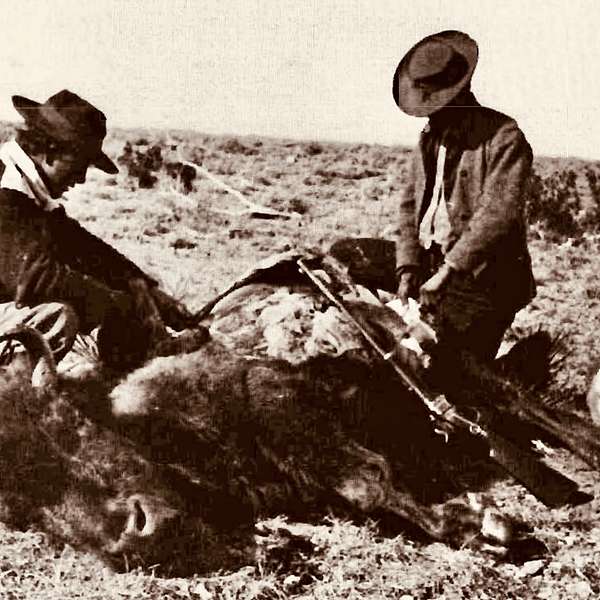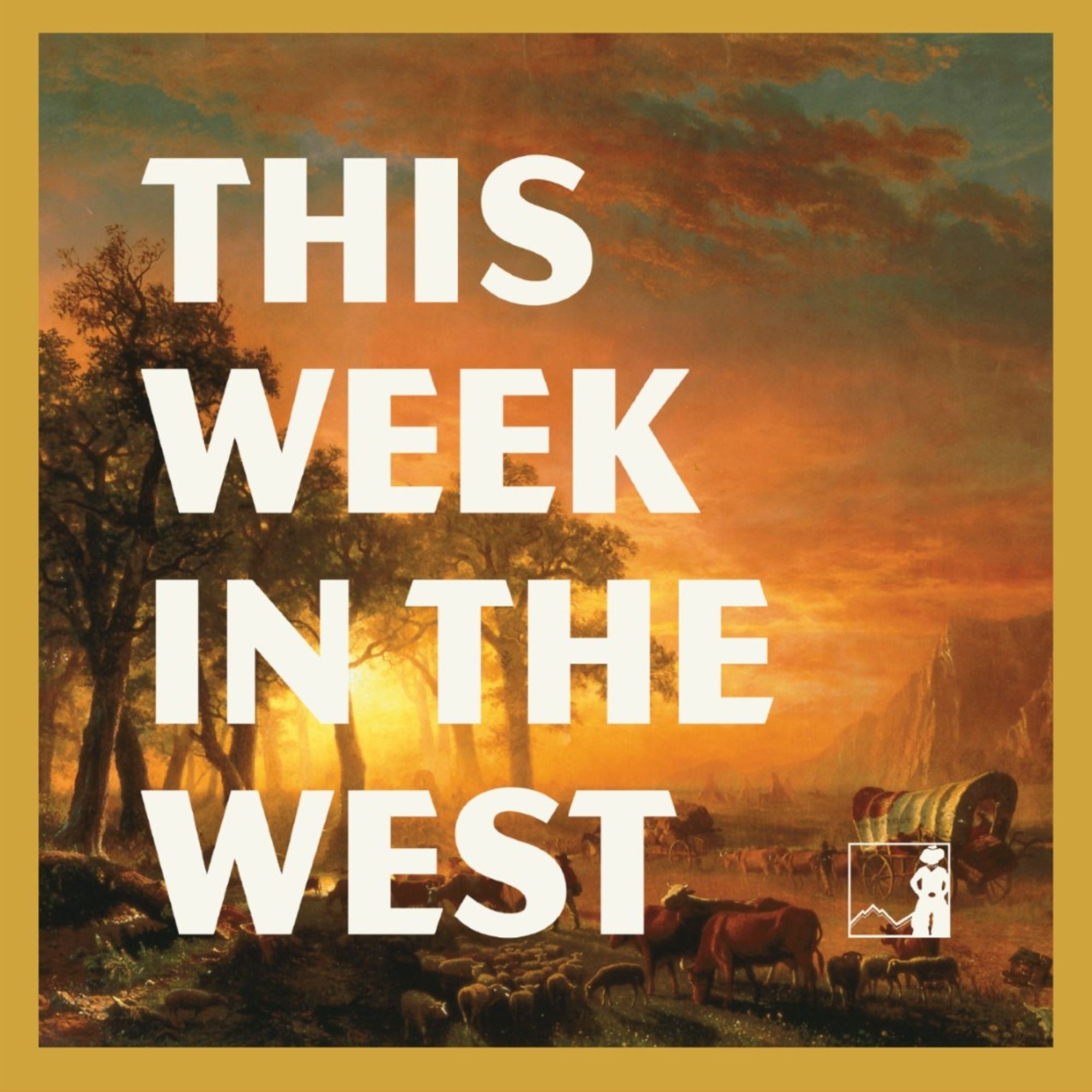
Wild West Podcast
Welcome to the Wild West podcast, where fact and legend merge. We present the true accounts of individuals who settled in towns built out of hunger for money, regulated by fast guns, who walked on both sides of the law, patrolling, investing in, and regulating the brothels, saloons, and gambling houses. These are stories of the men who made the history of the Old West come alive - bringing with them the birth of legends, brought to order by a six-gun and laid to rest with their boots on. Join us as we take you back in history to the legends of the Wild West. You can support our show by subscribing to Exclusive access to premium content at Wild West Podcast + https://www.buzzsprout.com/64094/subscribe or just buy us a cup of coffee at https://buymeacoffee.com/wildwestpodcast
Wild West Podcast
Unearthing the Buffalo Dystopia: The Catastrophe of Overhunting and the Medicine Lodge Treaty Consequences
Imagine the southern plains once teeming with 50 million buffaloes, a resource so vast it was considered inexhaustible. Then, picture it transforming into a desolate, putrid desert, the aftermath of a rampant hunting spree fueled by the discovery of buffalo leather by tanneries worldwide, the westward migration of war veterans and the establishment of railroads. This episode takes you on an engrossing journey through this pivotal, and often ignored chapter of American history. We'll discuss how the pursuit of quick wealth led to the unintentional theft of the Indians' livelihood and the severe disruption of natural replenishment, leaving the plains a wasteland and the once-thriving buffalo population in shambles.
Fast forward to 1872, when the big hunt left the Arkansas buffalo herd in ruins, and hunters began encroaching on the Indian hunting grounds in southwestern Kansas. We'll recount riveting tales of their encounters with the military and the shocking scale of devastation through Lieutenant Colonel Dodge's eyes. The devastation was so profound that the plains, once bustling with buffalo life, were now filled with a sickening stench from the myriad of carcasses left to rot. The episode continues with a deep dive into the Medicine Lodge Treaty of 1867 and its implications for the buffalo hunting grounds. Join us as we shed light on this significant period of American history, a time of rapid change and devastating loss.
At one time the buffalo were thought to be a boundless resource. Even the Indians doubted at first that these huge, thundering animals could ever be vanquished. In 1867, the buffalo count in the southern plains estimated at nearly 50 million. But by 1869, tanneries all over the world discovered the wonders of buffalo leather. In the 1870s everything changed. The war was over and hundreds of veterans many who lost everything to the battle between the states moved westward in search of a renewal. The railroads had pushed into Kansas but then stopped dumping hundreds of unwaged men idle for work. The quick solution for many was to get a rifle and a horse and set out to kill buffalo. The plains area became jammed with trading companies seeking to buy robes from the hundreds of buffalo hunters who had joined with skinners and teamsters to create a giant assembly line of death. For the most part, these men never considered that they were robbing the Indians of their livelihood. Nor did they find any reason to fret about the natural restocking of this valuable resource. They had come to make their fortune with shot and powder. They killed for the hides and left the meat to rot in the sun. It was a depreciation that the Indians could never understand. For them, the buffalo was a walking storehouse. It provided everything from clothing to fuel for the campfire. It was after the big hunt of 1872 that the Arkans' buffalo herd laid in remnants. The bones and carcasses were scattered into the breaks of the Simeron and the wilder countries southwest. In the spring of 72, almost all the buffaloes crossing over the Arkans' river had been annihilated. The railroad admitted hauling 1,378,359 buffalo hides between the years of 1872 and 1874. General Nelson A Miles said 4,373,730 buffaloes had fallen in the three years since the hunters moved down into the Arkans' river valley.
Speaker 1:By 1873, the buffalo hunters had already invaded the Indian hunting grounds in southwestern Kansas. These enthusiastic buffalo hunts to the south of the Arkans' river occurred without interference from the army. In the fall of that same year Lieutenant Colonel Dodge with a company of troops rode over the central plains of Kansas. He had been told of the devastation caused the year before from the big hunt. Colonel Dodge wanted to see for himself the magnitude of carnage the buffalo hunter had wreaked over the central buffalo herds. He merely replied into his journal. Upon return to the fort when there were many herds of buffalo the year before, there were now myriads of carcasses. The air was foul with a sickening stench and the vast plain which, only a short 12 months before, teamed with animal life, was a dead, solitary, putrid desert. A Santa Fe railway conductor, j H Helton, said he could have walked for 100 miles along the right of way without stepping off the carcasses, so great was the slaughter that in 1872 and 1873, the railroad hauled 1,250,000 hides out of Kansas in nearby territory.
Speaker 1:Now that the central buffalo herd had grown near extinction, a new hunting ground had to be established. In search of the new buffalo herds, j Wright Moore and John Webb saddled their horses and took a trip through the Texas Panhandle. For five days they rode through a sea of grazing buffaloes. Their report excited the other hunters, but there was some hesitation because of the Medicine Lodge Treaty of 1867. The treaty was made to reserve the rights for Kayawas, comanches, southern Cheyennes and Arapahos. Many of these tribes were allowed to hunt the lands south of the Arkansas River. These were the hunting grounds heavily patrolled by the troops from Fort Dodge. The military patrols were given the strictest orders to confiscate the buffalo hunters' mule teams, wagons and supplies if caught crossing the Cimarron. On the other hand, texas, which owned the land now in question, had not been partied to the treaty.
Speaker 1:Little Frazier proposed that the Hyde men send a delegation to Fort Dodge to ask its commander, lieutenant Colonel Dodge to the, what the penalty would be if the hunters crossed into the Texas panhandle, where they knew Buffalo was still abounded. According to Buffalo runner J Wright Moore, who went with Frazier to the Fort Dodge, received them very cordially. After canceling his other engagements, wright Moore asked advice from the commander of the 3rd Infantry at Fort Dodge, richard Irving Dodge. He, like most of his comrades in arms, believed that the Indian problem would be resolved as soon as the Buffalo were gone. Boys, replied the officer, if I were hunting Buffalo I would go where the Buffalo are. Dodge then took the Hyde men by the hands, bet them goodbye and wish them success.
